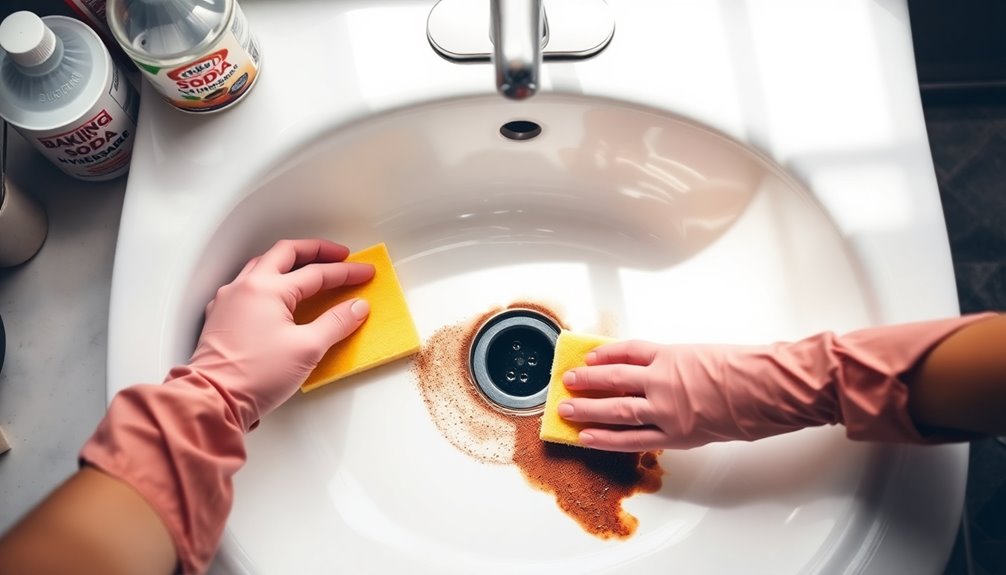To remove tough stains from your ceramic sink, start by sprinkling baking soda over the stained areas. Then, spray it with vinegar and let it fizz for a few minutes. Gently scrub with a non-abrasive sponge or use a mild abrasive cleaner for stubborn spots. Bar Keepers Friend can also work wonders. For heavy grime, a Magic Eraser might be your best bet. Curious about more effective techniques and tips? Keep on exploring!
Key Takeaways
- Create a baking soda paste by mixing baking soda and water, apply to the stain, and let it sit before scrubbing gently.
- Soak a soft cloth in white vinegar and place it on limescale for 10-15 minutes to dissolve buildup.
- Use lemon juice directly on stains for its natural whitening and stain-removing properties.
- Employ a non-abrasive sponge or a Magic Eraser to scrub persistent stains without scratching the ceramic surface.
- For extreme cases, mix equal parts bleach and water, apply to the stain, and rinse thoroughly afterward.
Understanding Your Ceramic Sink

Understanding your ceramic sink starts with recognizing its unique composition and characteristics. Ceramic sinks are crafted from non-metallic, inorganic compounds, giving them high density and strength. While this makes them durable, it also means they're susceptible to stains from certain substances.
Their smooth, glossy surface can show water spots, limescale, and food stains if not maintained regularly. To keep your ceramic sink looking its best, use gentle cleaning methods. Opt for mild, non-abrasive solutions like dishwashing liquid, and avoid harsh chemicals, which can damage the ceramic glaze.
Household items like baking soda, vinegar, and lemon juice work wonders for tackling tough stains without harming the surface. By choosing the right cleaning product, you'll keep your sink pristine for longer.
Essential Cleaning Supplies
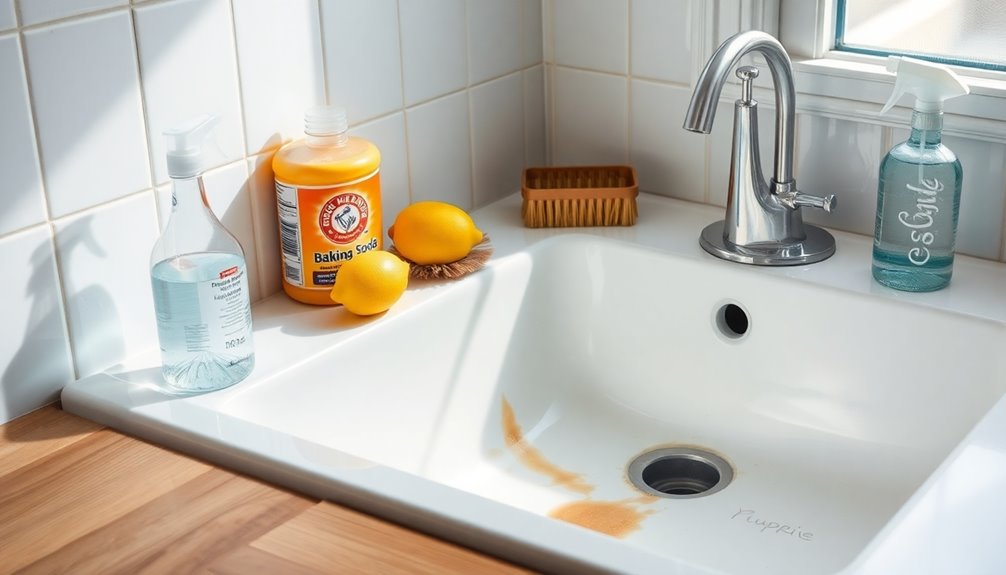
To effectively tackle tough stains in your ceramic sink, you'll need a few essential cleaning supplies.
Common items like baking soda, vinegar, and lemon juice can work wonders, while a non-abrasive sponge is vital to protect the surface.
For stubborn stains, consider adding a mild abrasive cleaner to your toolkit for safe and effective results.
Recommended Cleaning Products
When tackling tough stains on your ceramic sink, having the right cleaning products at your disposal makes all the difference.
For effective cleaning, consider using Bar Keepers Friend, a mild cleanser that's safe for ceramic surfaces and great at lifting grime.
Lemon juice is another excellent option; its citric acid works wonders as a natural stain remover, especially if you let it sit for about 30 minutes before rinsing.
For those persistent stains, grab a Magic Eraser, which provides additional cleaning power without scratching the surface.
If you're dealing with limescale buildup, soaking a soft cloth in white vinegar can help dissolve it.
Just remember to avoid concentrated bleach, but a diluted solution can be useful for soaking tough stains. Additionally, using aromatherapy scents can create a pleasant environment while you clean, enhancing your overall mood and reducing stress.
Natural Cleaning Alternatives
While commercial products can be effective, natural cleaning alternatives offer a safe and eco-friendly way to tackle tough stains on your ceramic sink.
Start with baking soda; mix it with water to create a paste that can effectively target stubborn stains without causing damage.
For a revitalizing approach, try lemon juice, which whitens surfaces and removes stains when left to sit on the affected area.
Vinegar works wonders too—apply it with a soft cloth to dissolve limescale and restore shine.
You can also make a paste of cream of tartar and vinegar for a powerful scrub.
Regularly using a 50% mix of water and white vinegar will help maintain your sink's appearance and prevent buildup.
Initial Cleaning Steps

Before diving into tougher stain removal techniques, it's essential to start with a thorough initial cleaning of your ceramic sink.
Follow these steps for effective cleaning:
- Clear the sink: Remove any food particles or debris to prevent bacteria and mineral buildup.
- Apply dishwashing liquid: Pour a small amount of dishwashing liquid onto the sink surface. Use a soft sponge to create a foam, targeting tough spots.
- Rinse and dry: After letting the dishwashing liquid sit for a few minutes, scrub gently, then rinse with warm water to remove any residue.
Finally, dry the sink with a microfiber cloth for a polished, streak-free finish.
These initial steps set the stage for deeper cleaning techniques later on.
Deep Cleaning Techniques

When tough stains linger, it's time to break out some powerful deep cleaning techniques.
You can use vinegar to tackle limescale, or create a baking soda paste for stubborn stains.
Don't forget about lemon juice, which can naturally whiten your sink while lifting away grime.
Vinegar for Limescale Removal
Vinegar is one of the most effective and natural solutions for tackling limescale buildup in your ceramic sink. This acidic powerhouse breaks down calcium carbonate deposits, making it easy to remove stains.
Here's how to use vinegar for limescale removal:
- Soak a soft cloth or sponge in vinegar and scrub the affected areas.
- For stubborn limescale, apply vinegar directly and let it sit for 10-15 minutes before scrubbing.
- Rinse your sink with warm water to remove any remaining residue.
Regularly cleaning your sink with vinegar can help maintain its appearance and prevent limescale buildup from becoming a persistent issue.
You'll enjoy a sparkling, stain-free sink with minimal effort!
Baking Soda Paste Application
Transform your ceramic sink's appearance with a simple baking soda paste that effectively tackles tough stains.
To make this paste, mix about ½ cup of baking soda with enough water to achieve a thick consistency. Spread the paste directly onto the stained areas, ensuring even coverage for maximum effectiveness.
Let it sit for 15-30 minutes to allow the natural alkalinity of baking soda to break down the grime.
After the waiting period, grab a damp non-abrasive sponge and gently scrub the area to lift the stains without scratching your sink.
Finally, rinse the sink thoroughly with warm water to remove any remaining baking soda residue, revealing a cleaner, brighter surface.
Your ceramic sink will look refreshed and revitalized!
Lemon Juice Whitening Effect
Lemon juice is a powerful ally in your quest to restore the shine of your ceramic sink. Its citric acid works wonders on stubborn stains, providing an impressive whitening effect.
Here's how to use it effectively:
- Apply lemon juice directly to the stained area and let it sit for about 30 minutes.
- For tougher stains, mix lemon juice with baking soda to create a paste and gently scrub the surface.
- Alternatively, rub lemon wedges on the stains, using the rind for added scrubbing power.
After treating the stains, be sure to rinse the sink thoroughly with warm water to remove any residue.
This simple technique can help you maintain a sparkling clean ceramic surface!
Natural Stain Removal Methods
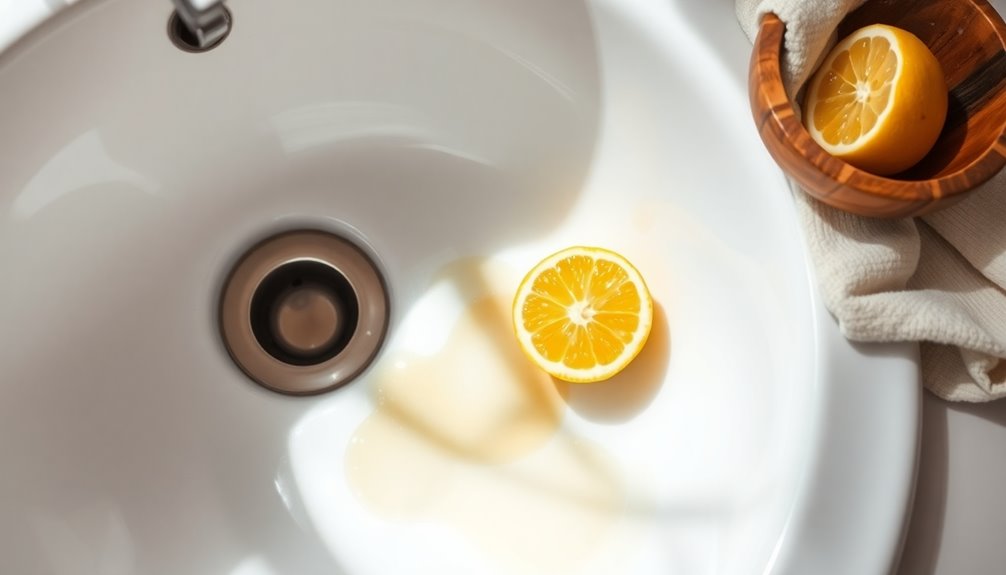
Tough stains on a ceramic sink can be frustrating, but natural methods offer effective solutions.
Start by making a baking soda paste with water, applying it to the stains, and letting it sit for 10-15 minutes. Gently scrub with a soft sponge to lift the stains.
For limescale, soak a soft cloth in vinegar and place it on the affected area for about 10 minutes, then scrub to dissolve the buildup.
Alternatively, mix cream of tartar with vinegar in a 1:1 ratio, apply it to stubborn stains, and let it sit for 10 minutes before scrubbing.
For tight spots, use a soft-bristled toothbrush dipped in baking soda paste for precise cleaning without scratching your sink.
Tips for Maintaining Your Sink
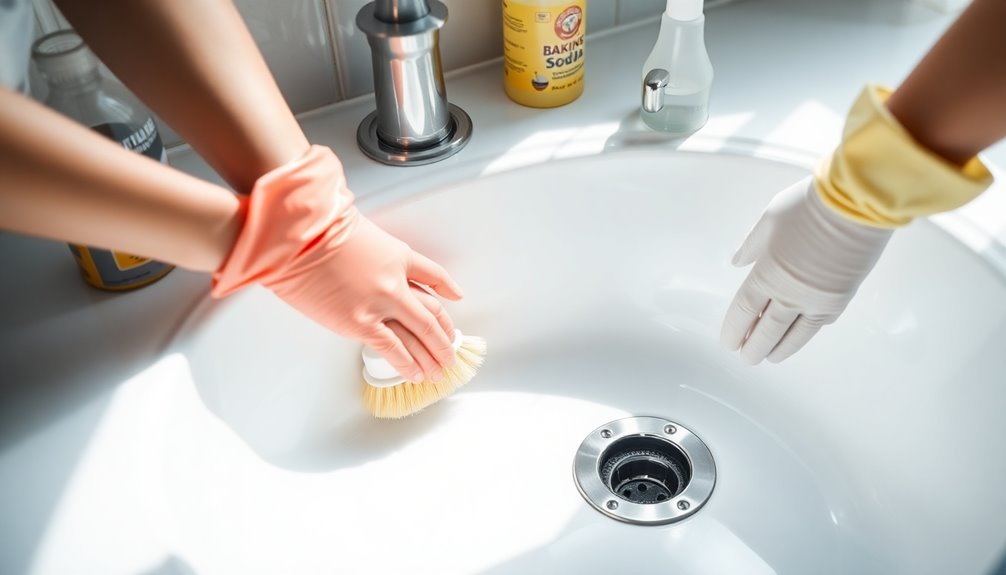
To keep your ceramic sink looking great, set up a regular cleaning schedule to prevent stains and buildup.
Always avoid harsh chemicals that can damage the surface and compromise its shine.
Regular Cleaning Schedule
Regularly maintaining your ceramic sink can make a significant difference in keeping it spotless and stain-free.
By establishing a regular cleaning routine, you can effectively combat stains and grime.
Follow these steps for ideal care:
- Daily Care: Wipe down your sink with warm soapy water after each use to prevent buildup.
- Weekly Deep Clean: Once a week, gently scrub the sink with a mixture of baking soda and water to tackle any minor stains before they set.
- Monthly Shine: Use natural solutions like vinegar or lemon juice to maintain the sink's shine and tackle limescale.
Remember to always dry your sink with a soft cloth after cleaning to avoid water spots.
Regular inspections for chips or scratches will help keep your sink looking its best.
Avoid Harsh Chemicals
Maintaining a clean ceramic sink is not just about routine; it's also about the products you use. To keep your sink in top shape, avoid using harsh chemicals like bleach and abrasive scrubbers, as they can damage the ceramic surface and erode its glaze. Instead, opt for natural cleaning solutions like vinegar and baking soda.
| Do's | Don'ts | Benefits |
|---|---|---|
| Use natural cleaning solutions | Avoid using harsh chemicals | Protects the ceramic surface |
| Rinse and dry after use | Don't let stains sit | Prevents mineral buildup |
| Use soft sponges | Avoid abrasive scrubbers | Maintains protective coating |
Regularly rinsing and drying your sink helps prolong its lifespan and keeps it looking new. Consider applying a protective coating for added defense.
Protecting Your Sink From Damage
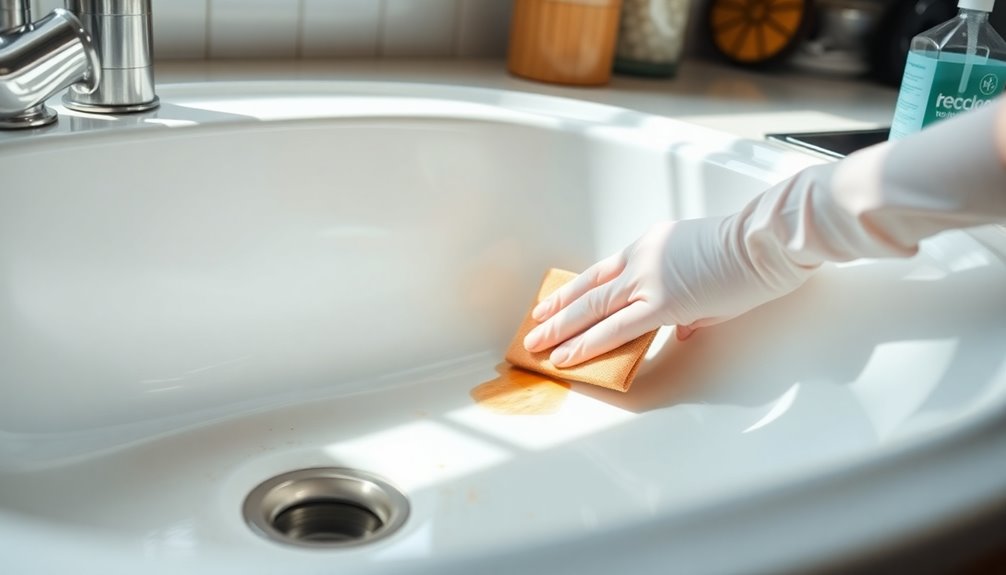
Protecting your ceramic sink from damage is essential for preserving its beauty and functionality. Here are some vital steps to help you maintain its integrity:
- Use a soft, non-abrasive sponge for cleaning. This prevents scratches that can damage the surface and ruin the glaze.
- Avoid harsh chemical cleaners that can erode the finish. Stick to gentle, pH-balanced products to keep your sink looking pristine.
- Dry your sink after each use to prevent water spots and mineral buildup, which can compromise its appearance over time.
Regularly inspect your sink for chips or scratches, and address any issues promptly.
Consider applying a protective coating designed for ceramic surfaces to further protect and simplify future cleaning.
Common Cleaning Mistakes to Avoid

While it might be tempting to use whatever cleaning supplies you have on hand, some common mistakes can seriously harm your ceramic sink.
First, avoid using abrasive scrubbers or pads; they can scratch the surface and lead to permanent damage.
Don't rely on harsh chemicals like bleach or concentrated drain cleaners, as these can erode the ceramic material.
Also, steer clear of scouring powders or gritty cleaners, which can create micro-scratches, trapping dirt and stains.
Products containing chlorine should be avoided, as they can weaken the glaze and cause discoloration.
Finally, don't let stains sit too long; dried stains become much harder to remove and can damage the surface if you're not careful.
Expert Recommendations for Stubborn Stains

Even with the right cleaning practices, stubborn stains can still make your ceramic sink look less than pristine.
Here are some expert recommendations to tackle these tough spots:
- Baking Soda Paste: Create a paste with baking soda and water. Apply it directly to the stain, let it sit for 15-30 minutes, then scrub away with a non-abrasive sponge.
- Limescale Treatment: For limescale buildup, soak a cloth in white vinegar and place it on the affected area for 10-15 minutes to dissolve the deposits.
- Bleach and Water: If all else fails, mix bleach and water (1:1 ratio). Apply it as a last resort, but make sure to rinse thoroughly to protect the ceramic surface.
Reader Experiences and Success Stories
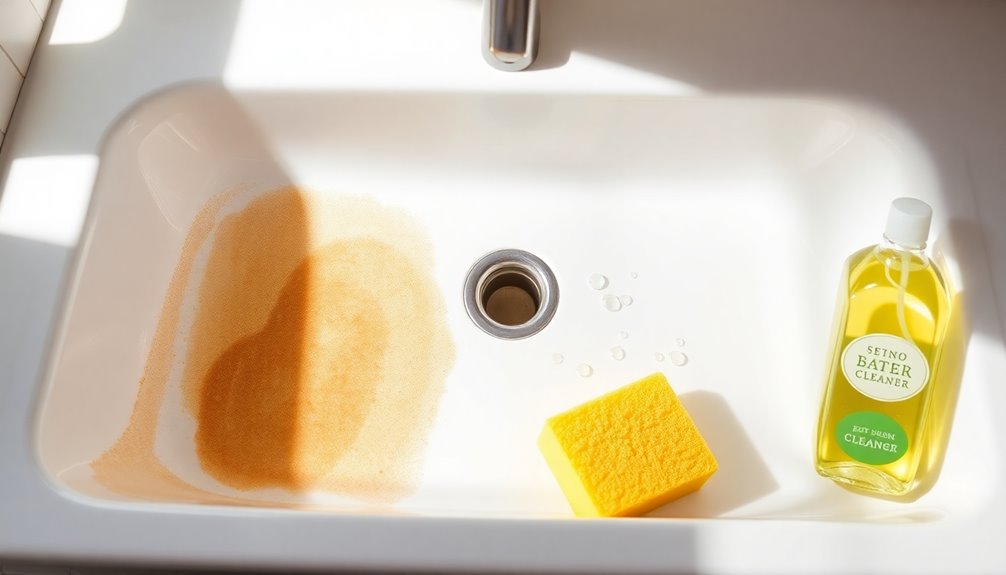
Many readers have found success in tackling tough stains on their ceramic sinks using simple household items.
One popular method involves creating a paste of baking soda and water, applying it to the stains, and letting it sit for 15 minutes before gently scrubbing with a non-abrasive sponge.
Others swear by a mixture of vinegar and baking soda, noting that the fizz helps lift grime effectively.
Some have even used lemon juice to brighten surfaces, leaving a fresh scent afterward.
A Mr. Clean Magic Eraser is another favorite, praised for removing tough marks without damaging the ceramic.
For deep cleaning, soaking the sink in a bleach and water solution for 10 minutes can also lighten those stubborn stains.
Frequently Asked Questions
How Do You Clean a Badly Stained Ceramic Sink?
To clean a badly stained ceramic sink, start by making a paste with baking soda and water, applying it to the stains.
Let it sit for 15-20 minutes before gently scrubbing with a soft sponge.
For tougher stains, try soaking a cloth in vinegar and scrubbing the area.
If needed, apply lemon juice directly and let it sit.
Regular rinsing and using gentle cleaners can help prevent future stains from forming.
How Do You Get Deep Stains Out of a Sink?
You've got deep stains in your sink, and they're not budging, right? It's frustrating, but don't worry; there's a way out.
Start by mixing baking soda and water into a paste. Apply it to the stains and let it sit for about 30 minutes.
Then, grab a non-abrasive sponge and gently scrub. For extra power, consider soaking stubborn spots with vinegar, or try lemon juice for a natural boost.
How Do You Make a Ceramic Sink Look New?
To make your ceramic sink look new, start by cleaning it regularly with a baking soda and water mixture. This lifts grime without harming the surface.
For tougher stains, apply a baking soda paste, let it sit for 10-15 minutes, then scrub gently.
Use white vinegar to dissolve limescale and lemon juice for a natural shine.
Finally, dry the sink after each use to prevent water spots and keep it looking polished.
How Do You Remove Tough Stains From Ceramic?
To remove tough stains from ceramic, start by creating a paste of baking soda and water. Apply it to the stains and let it sit for 10-15 minutes.
For limescale, use vinegar on a soft cloth, allowing it to sit briefly before rinsing. If stains linger, mix lemon juice with baking soda and apply directly.
A soft-bristled toothbrush can help scrub tight spots. For stubborn issues, a diluted bleach solution can be a last resort.
Conclusion
In the battle against tough stains, your ceramic sink can shine like new with the right approach. By understanding your sink, using essential supplies, and employing effective techniques, you can reclaim its beauty. Remember, prevention is key—protect your sink from future damage. With a bit of patience and the right methods, those stubborn stains will vanish, leaving you with a gleaming surface that reflects your hard work. Embrace the shine and enjoy your sparkling clean sink!
